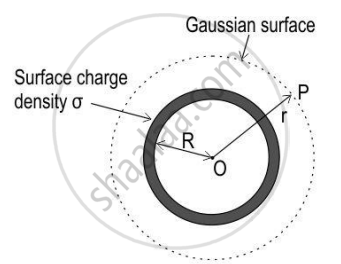Advertisements
Advertisements
प्रश्न
“A uniformly charged conducting spherical shell for the points outside the shell behaves as if the entire charge of the shell is concentrated at its centre”. Show this with the help of a proper diagram and verify this statement.
उत्तर
A shell of radius R is carrying uniformly distributed charge of charge density σ.

Electric field E at point P at a distance r from the centre of a uniformly charged spherical shell:
Consider a Gaussian surface to be a sphere of radius r >R and with centre O, passing through P.
Using the principles of spherical symmetry, E and area vector ΔS at every point are parallel, flux through each of the area element.
ΔΦ = E. ΔS
Summing over all ΔS,
Φ = E × 4 π R2
The charge enclosed is σ × 4 π R2
By Gauss’ law,
`"E" xx 4 pi "r"^2 = "q"/ε_o = (σ "X" 4pi "R"^2)/ε_o`
`"E" = (σ "R"^2)/(ε_o "r"^2) = "q"/(4 pi ε_o "r"^2)`
This formula is exactly similar to the field produced by a point charge q placed at the centre O, that is, as per Coulomb’s law.
APPEARS IN
संबंधित प्रश्न
Two large, thin metal plates are parallel and close to each other. On their inner faces, the plates have surface charge densities of opposite signs and of magnitude 17.0 × 10−22 C/m2. What is E:
- in the outer region of the first plate,
- in the outer region of the second plate, and
- between the plates?
Find the ratio of the potential differences that must be applied across the parallel and series combination of two capacitors C1 and C2 with their capacitances in the ratio 1 : 2 so that the energy stored in the two cases becomes the same.
An infinitely large thin plane sheet has a uniform surface charge density +σ. Obtain the expression for the amount of work done in bringing a point charge q from infinity to a point, distant r, in front of the charged plane sheet.
Using Gauss's law in electrostatics, deduce an expression for electric field intensity due to a uniformly charged infinite plane sheet. If another identical sheet is placed parallel to it, show that there is no electric field in the region between the two sheets ?
A point object is placed on the principal axis of a convex spherical surface of radius of curvature R, which separates the two media of refractive indices n1 and n2 (n2 > n1). Draw the ray diagram and deduce the relation between the object distance (u), image distance (v) and the radius of curvature (R) for refraction to take place at the convex spherical surface from rarer to denser medium.
Using Gauss’s law, prove that the electric field at a point due to a uniformly charged infinite plane sheet is independent of the distance from it.
A spherical shell made of plastic, contains a charge Q distributed uniformly over its surface. What is the electric field inside the shell? If the shell is hammered to deshape it, without altering the charge, will the field inside be changed? What happens if the shell is made of a metal?
A positive point charge Q is brought near an isolated metal cube.
